This blog post was submitted by David Grice a systems architect at ZMD America.
Designing and implementing sensor interface designs for nonlinear, temperature-dependent transducers presents some difficult challenges. The advent of dedicated and powerful Sensor Signal Conditioning (SSC) ICs has made the job easier, but choosing the right IC for a particular sensor and application is critical for making optimal performance and cost tradeoffs. In this article we will examine some of the most important features and functions to consider when choosing the best SSC for your application.
Knowing your Sensor
The first step in choosing an SSC is to understand the characteristics of the sensor that it interfaces. Sometimes a designer is tempted to skip this step and pick an SSC with the most powerful and complex correction techniques that are available or affordable. This is not only wasteful in terms of cost and loading on expensive production testing resources, but often detrimental. Depending on the intelligence designed into the correction algorithms, sometimes a higher-order equation fit will create more error than a simpler equation that more closely matches the inherent response of the sensor. Characterizing and analyzing sensor behavior over all environments is time well spent.
The Right Partner
Before plodding through pages and pages of datasheets to understand every tedious detail of dozens of potential SSC candidates, take a step back and evaluate what level of support and overall experience the manufacturer provides with their products. This is especially important for a product like an SSC where complex equations are used to calculate the correction coefficients. If the manufacturer does not provide development hardware and software to automate and evaluate the calibration routines, you will be left to develop those resources on your own. Even more important is the ability and willingness of the manufacturer to answer questions about their product and support materials that routinely arise during the development phase.
Total System Cost
Another commonly overlooked factor in SSC selection is the production cost of calibration, especially for high-volume applications. Sometimes a cheaper part will actually end up costing more overall because it uses an unsophisticated calibration routine that requires more time on costly testers and environmental chambers. The ZMDI family of SSC products is designed with this in mind. Their intelligent correction algorithms allow for “single pass” calibration that minimizes the time required for data collection and for coefficient calculation and programming. This is a tremendous benefit and should be given serious consideration in the selection process.
Narrowing the Field
After selecting the right partner and family of products, the choice must be narrowed to an individual part. Typically, the process of elimination is the easiest and fastest way to accomplish this. For example, the ZMDI SSC product family is broadly divided into resistive and capacitive bridge sensor types. If your sensor is capacitive, the candidates will be limited to the ZSC312X series.
After sensor type, the next criteria that narrow the range of products most quickly are the qualification level and environmental requirements. For automotive level quality (AEC-Q100), the available choices are the ZSC31150, ZSSC3170, or one of the ZSSC31xx products. Applications that do not require automotive qualification can use any of the ZSC310xx or ZSSC30xx parts.
Once the field has been narrowed to this point, the remaining criteria for completing the selection process are operational constraints such as gain and resolution, response time, supply voltage and current, and output interface type (analog, I2C, SPI, etc.). If multiple parts meet all these requirements, the final selection can be made based on price or special features like alarm outputs or sensor diagnostics.
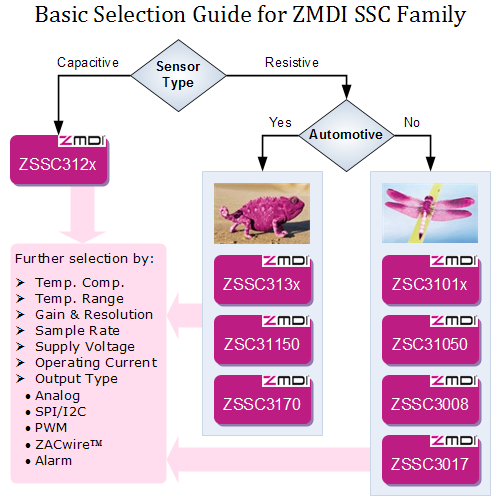
Options + Process + Experience = Success!
Abundance of choice can be a double-edged sword, but a methodical approach combined with an experienced partner will make the selection process smooth, efficient, and successful.
Learn more about sensor signal conditioning
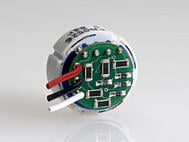 Ceramic pressure sensors typically use thick-film technology to create a low cost, stable, and robust media-compatible pressure sensor. These sensors are an excellent alternative to more expensive stainless steel pressure sensors or oil-filled sensors using silicon piezoresistive sensing elements for any application where an o-ring can be used.
Ceramic pressure sensors typically use thick-film technology to create a low cost, stable, and robust media-compatible pressure sensor. These sensors are an excellent alternative to more expensive stainless steel pressure sensors or oil-filled sensors using silicon piezoresistive sensing elements for any application where an o-ring can be used.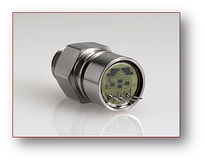 Packaging these sensors can be customized for your application or through use of standard housing which is also available. See the image here which shows standard housing. The sensor can be easily embedded in vales and pumps, opening the possibilities for better control in your application.
Packaging these sensors can be customized for your application or through use of standard housing which is also available. See the image here which shows standard housing. The sensor can be easily embedded in vales and pumps, opening the possibilities for better control in your application.

 We recently read a press release by a research company discussing pressure sensors and MEMS. We found the article to be very interesting and thought we would share some key points:
We recently read a press release by a research company discussing pressure sensors and MEMS. We found the article to be very interesting and thought we would share some key points:


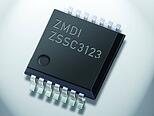 The new ZSSC3123 is a low power capacitive sensor signal conditioning IC that supports a broad range of sensor types and gives engineers a cost-effective component option for sensor designs.
The new ZSSC3123 is a low power capacitive sensor signal conditioning IC that supports a broad range of sensor types and gives engineers a cost-effective component option for sensor designs.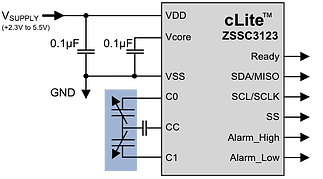 The ZSSC3123 can be configured to interface with capacitive sensors from 0.5 to 260 pF, with sensitivity as low as 125 atto-Farads per digital bit. The part can be used in both single and differential input sensor configurations. The device offers full 14-bit resolution for compensation of sensor offset, sensitivity and temperature.
The ZSSC3123 can be configured to interface with capacitive sensors from 0.5 to 260 pF, with sensitivity as low as 125 atto-Farads per digital bit. The part can be used in both single and differential input sensor configurations. The device offers full 14-bit resolution for compensation of sensor offset, sensitivity and temperature.
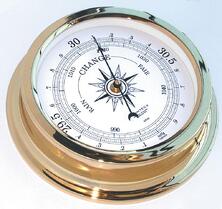 Why are we doing this survey?
Why are we doing this survey?
 Recently an article was published in Design News about digital humidity sensors offered by Servoflo.
Recently an article was published in Design News about digital humidity sensors offered by Servoflo.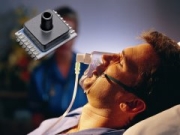 We have updated our medical applications area with the latest pressure sensor products. The goal of this section is to provide you with a quick and easy way to find sensors by application. Pressure sensors are becoming increasingly important in medical equipment. The latest technologies available give designers flexibility in how sensors are used. Lower tolerance sensors combined with sensor signal conditioning lets medical equipment designers choose more cost effective solutions while tailoring a sensor to their specific needs.
We have updated our medical applications area with the latest pressure sensor products. The goal of this section is to provide you with a quick and easy way to find sensors by application. Pressure sensors are becoming increasingly important in medical equipment. The latest technologies available give designers flexibility in how sensors are used. Lower tolerance sensors combined with sensor signal conditioning lets medical equipment designers choose more cost effective solutions while tailoring a sensor to their specific needs.